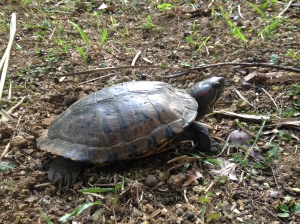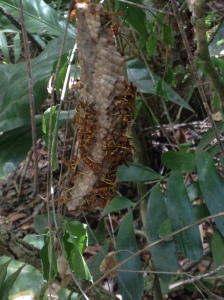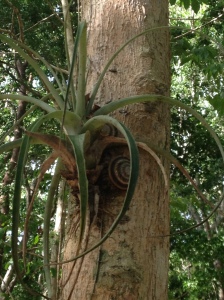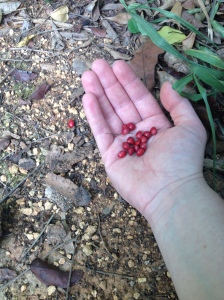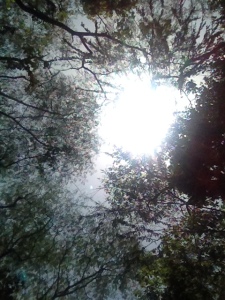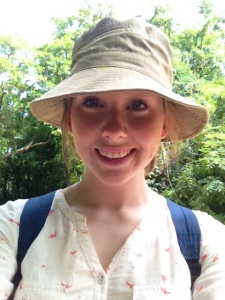So, besides all this exploring and discovering we are actually doing lots of work every day! Not your typical kind of work though. So to explain why I am actually spending a month of my summer hols in the Caribbean I can tell you that the overall aim of this project is to predict the responses of vegetation to the increasing levels of carbon dioxide in the atmosphere. This will be done by examining woody vegetation types in numerous destinations across nine of the world’s biomes and comparing the reactions of these plants with the same plant species from the same areas between the years 1989-92, which were collected by Jack Wolfe and are now present in a herbarium in Smithsonian Institution in Washington. So, there is a huge amount of travelling and sampling of plants to be done and I am here to assist Michelle, Wuu Kuang and Harry in their investigation of the different plant species in the forests of Puerto Rico, lucky me!!! 🙂
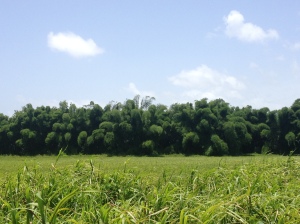
There are a few main steps involved in the fieldwork that is carried out over 4 or 5 days in each location. On the first day we check out the site trying to locate the plants on our list. The species list that we have for each location is all of the species that were examined and collected by Jack Wolfe many years ago. We found sticking to this list to be very frustrating at times as it always seemed like Wolfe chose the most simple and common plant species for his collection in a forest full of weird and wonderfully different types of trees, some with the biggest leaves you could imagine or the most uniquely shaped ones. But of course we must follow his footsteps and could only but admire these amazing specimens.
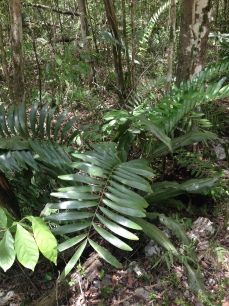
The next step in the process is measuring the leaves, and I don’t mean measuring the size of them! They are measured with numerous different instruments for at least three successive days !!! I had never seen any of these instruments before and after seeing them in Cambalache on the first day of measuring I expected their operation to be a lot more complex than it was! One leaf on each tree is chosen to measure every day and the first measurement that is taken is the rate of conductance of gases through the leaf. This measurement is taken with a porometer, which resembles an old Gameboy with a clip attached to it to clip onto the leaf. It measures the rate of water vapor exiting the leaf through thousands of tiny pores called stomata (photo). Next a hygrometer is used to measure the relative humidity and the temperature around the leaf; this involves holding a microphone like object up to the leaf as if waiting for it to tell you how hot and sweaty it feels! The device then gives us a reading for the RH and temperature and I record this on our data sheet. Michelle took charge of both of these instruments. The final measurement is taken by an instrument called a ceptometer and this is the one which I have been using each day. This device measures the level of light radiating on the leaf that can be used for photosynthesis. Each of these devices is very easy to use and once you get the first few plants done each morning each measurement becomes almost automatic.
The measuring itself is quite repetitive so it’s difficult at times to stay focused and this is when we ended up missing a specimen on our way and having to backtrack, which ended up wasting some time. I feel myself and Michelle worked well together, we certainly got a rhythm going and while we stopped occasionally for a much-needed sugar fix, collect some souvenirs along the trail or had an episode with the GPS, we worked pretty efficiently overall.
While myself and Michelle take the measurements the two boys have other tasks to occupy themselves with. Harry is here to measure the rate of photosynthesis in some of the taller tree species that we have to measure. He does this by using a long pole with a scythe attached to the end to cut off some small branches from the top of the taller trees and then measures them using a very complex looking machine called CIRAS. The pole is very handy for this job but there have been a few hiccups with this infamous tool! Lets just say that it’s not as long as it used to be!!!
Meanwhile Wuu Kuang is busy taking notes on all the different specimens we are sampling, locating ones that we have not found yet or helping Harry to find some good trees to measure!
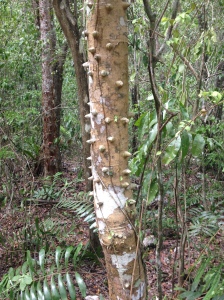
So, we spent five days measuring in Cambalache and after this the leaves that we have been measuring are all collected along with some extras and must be then pressed and posted off to the lab at home, where they will await the return of these guys to carry out some further analysis on them. We also collect three duplicate leaves or, in some cases, small twigs with leaves to be pressed and sent to three herbaria, one being the Smithsonian Institution herbarium in Washington, another is the herbarium in the National botanic Gardens in Glasnevin and then one extra specimen is also sent to UCD to be included in their herbarium.
The task of organizing and pressing all these plants I thought was unexpectedly long and tedious. We divided the leaves between the two rooms and while it took myself and Michelle most of the evening, the boys managed to get in a couple of hours by the pool….we think the boys ‘accidentally’ miscalculated when dividing the leaves!!
Okay so now you can gather the routine that is followed at each site! There are very early mornings involved, long hours of measuring and then afternoons to input data or press plants! The hard work is worth it though to see some of the places we have been and just to be working out in the forest each day. We stumble upon something new in the field each day, no two days have been the same!!
Check out a few of the pictures I have taken so far on my adventure and I’ll have another update here soon on our next site and the adventure we had finding BOSQUE ESTATAL DE GUAJATACA!
